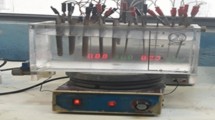Abstract
This study was conducted to explore the possibility of increasing the efficiency of electro-flotation in two ways: (1) by using an appropriate electrode capable of generating more microbubbles and (2) by introducing flocculation. The generation of more microbubbles was achieved by using an electrode with higher surface area. To further increase the removal efficiency, two inorganic \([\hbox {Al}_{2}(\hbox {SO}_{4})_{3}\) and \(\hbox {Fe}_{2}(\hbox {SO}_{4})_{3}]\) and two polymer coagulants (PAC and polymer anion) were used as enhancements to electro-flotation. The results showed that 3 out of the 4 coagulants used have the capacity to remove 95% of microalgae in 1 L of suspension by using electro-flotation. By retrofitting flocculation into electro-flotation, the coagulant dose was significantly decreased in comparison with conventional flocculation process. Moreover, 95% removal of microalgae suspension from local eutrophic river (Nakdong river) was achieved also with PAC by enhanced electro-flotation. The results of this study also showed that the current method tremendously decreased the coagulant consumption as compared to other removal methods such as flocculation and flotation by DAF as mentioned in the later section of this study. Hence, it is an economical microalgae removal method and at the same time an efficient way to reduce water contamination due to excessive doses of coagulant.
Similar content being viewed by others
References
Rai, A.N.: CRC Handbook of Symbiotic Cyanobacteria. CRC Press, Boca Raton (1990)
Skulberg, O.M.: Biophotolysis, hydrogen production and algal culture technology. Hydrog. Energy Syst. NATO ASI Ser. 295, 95–110 (1995)
Chorus, I.; Bartram, J.: Toxic cyanobacteria in Water: A Guide to Their Public Health Consequences, Monitoring and Management. E&FN Spon, London (1999, imprint of Routledge)
Dittmann, E.; Weigand, C.: Cyanobacterial toxins-occurrence, biosynthesis and impact on human affairs. Mol. Nutr. Food Res. 50, 1–17 (2006)
Burns, S.E.; Yiacoumi, S.; Tsouris, C.: Microbubble generation for environmental and industrial separations. Sep. Purif. Technol. 11, 221–232 (1997)
Misra, R.; Guldhe, A.; Singh, P.; Rawat, I.; Bux, F.: Electrochemical harvesting process for microalgae by using nonsacrificial carbon electrode: a sustainable approach for biodiesel production. Chem. Eng. J. 255, 327–333 (2014)
Zhou, W.; Gao, L.; Cheng, W.; Chen, L.; Wang, J.; Wang, H.; Zhang, W.; Liu, T.: Electro-flotation of Chlorella sp. assisted with flocculant by chitosan. Algal Res. 18, 7–14 (2016)
Park, Y.S.; Kim, D.S.: Study on bubble generation and size by dimensionally stable anode in electroflotation process. J. Environ. Sci. Int. 16(10), 1189–1195 (2007)
Vandamme, D.; Pontes, S.; Goiris, K.; Foubert, I.; Pinoy, L.; Muylaert, K.: Evaluation of electro-coagulation–flocculation for harvesting marine and freshwater microalgae. Biotechnol. Bioeng. 108, 2320–2329 (2011)
Bennett, A.J.R.; Champmen W.R.; Dell C.C.: Studies in the froth flotation of coal. In: Third International Coal Preparation Congress. Brussels-Leige, pp. 452–462 (1958)
Vogt, H.: In: Yeager, E., Bockris, J.O’.M., Conway, B.E., Sarangapani, S. (eds.) Comprehensive Treatise of Electrochemistry, vol. 6. Plenum Press, New York (1983)
Lumanauw, D.: Hydrogen Bubble Characterization in Alkaline Water Electrolysis. Master’s thesis. Graduate Department of Metallurgy and Materials Science. University of Toronto (2000)
Gebbie, P.: Using polyaluminium coagulants in water treatment. In: 64th Annual Water Industry Engineers and Operators’ Conference. Bendigo, pp. 39–47 (2001)
Gerardo, M.L.; Van Den Hende, S.; Vervaeren, H.; Coward, T.; Skill, S.C.: Harvesting of microalgae within a biorefinery approach: a review of the developments and case studies from pilot-plants. Algal Res. 11, 248–262 (2015)
Ndikubwimana, T.; Zeng, X.; He, N.; Xiao, Z.; Xie, Y.; Chang, J.S.; Lin, L.; Lu, Y.: Microalgae biomass harvesting by bioflocculation-interpretation by classical DLVO theory. Biochem. Eng. J. 101, 160–167 (2015)
Henderson, R.K.; Parsons, S.A.; Jefferson, B.: The potential for using bubble modification chemicals in dissolved air flotation for algae removal. Sep. Sci. Technol. 44, 1923–1940 (2009)
Laamanen, C.A.; Ross, G.M.; Scott, J.A.: Flotation harvesting of microalgae. Renew. Sust. Rev. 58, 75–86 (2016)
Bolto, B.; Gregory, J.: Organic polyelectrolytes in water. Water Res. 41, 2301–2324 (2007)
Chatsungnoen, T.; Chisti, Y.: Harvesting microalgae by flocculation-sedimentation. Algal Res. 13, 271–283 (2016)
Liu, J.; Zhu, Y.; Tao, Y.; Zhang, Y.; Li, A.; Li, T.; Sang, M.; Zhang, C.: Freshwater microalgae harvested via flocculation induced by pH decrease. Biotechnol. Biofuels 6(98), 1–11 (2013)
Ummalyma, S.B.; Mathew, A.K.; Pandey, A.; Sukumaran, R.K.: Harvesting of microalgal biomass: efficient method for flocculation through pH modulation. Bioresour. Technol. 213, 216–221 (2016)
Gerde, J.A.; Yao, L.; Lio, J.; Wen, Z.; Wang, T.: Microalgae flocculation: impact of flocculant type, algae species and cell concentration. Algal Res. 3, 30–35 (2014)
Crapper, D.R.; Krishnan, S.S.; Dalton, A.J.: Brain aluminum distribution in Alzheimer’s disease and experimental neurofibrillary degeneration. Science 180, 511–513 (1973)
Kim, S.K.; Kim, D.K.; Kang, S.; Ahn, J.H.; Kim, I.H.; Yun, S.L.; Lee, S.H.; Lee, W.T.: Removal of algae by natural coagulants of soil origin. J. Korean Soc. Environ. Eng. 35(12), 883–888 (2013)
Sirin, S.; Trobajo, R.; Ibanez, C.; Salvado, J.: Harvesting the microalgae Phaeodactylum tricornutum with polyaluminum chloride, aluminium sulphate, chitosan and alkalinity-induced flocculation. J. Appl. Phycol. 24, 1067–1080 (2012)
Wyatt, N.B.; Gloe, L.M.; Brady, P.V.; Hewson, J.C.; Grillet, A.M.; Hankins, M.G.; Pohl, P.I.: Critical conditions for ferric chloride-induced flocculation of freshwater algae. Biotechnol. Bioeng. 109, 493–501 (2012)
Kwon, H.; Lu, M.; Lee, E.Y.; Lee, J.: Harvesting of microalgae using flocculation combined with dissolved air flotation. Biotechnol. Bioprocess Eng. 19, 143–149 (2014)
Author information
Authors and Affiliations
Corresponding author
Rights and permissions
About this article
Cite this article
Lucero, A., Park, YS. & Kim, DS. Removal of Freshwater Microalgae by Flocculation-Enhanced Electro-flotation Using Stainless Steel Mesh Electrode. Arab J Sci Eng 43, 2339–2351 (2018). https://doi.org/10.1007/s13369-017-2712-y
Received:
Accepted:
Published:
Issue Date:
DOI: https://doi.org/10.1007/s13369-017-2712-y




